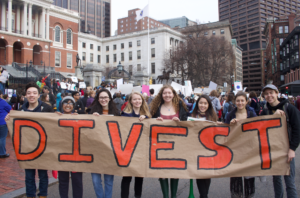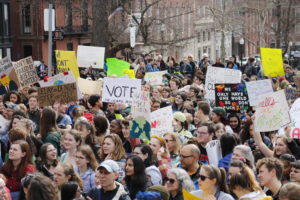On Friday, March 15, over 1.4 million high school students in more than 300 cities around the world took to the streets to demand serious climate action from their representatives. With the latest report by the Intergovernmental Panel on Climate Change and the National Climate Assessment forecasting disastrous effects of climate change in the next few decades, these students maintain that the time to act is now.
What became a global movement began as a single act of civil disobedience. Inspired by the Parkland student activists who organized the March for Our Lives, 16-year-old Greta Thunberg staged a lone school strike to protest climate inaction in the lead-up to the Swedish general elections last September. Her protest inspired the Fridays for the Future campaign, which quickly attracted mass media attention and earned a following from teens across European cities. The youth climate strike movement has since spread around the world, mobilizing high schoolers from New York City to Melbourne, while Thunberg’s impressive activism has earned her a Nobel Peace Prize nomination.
Already, the school strike movement has garnered attention from government representatives, with U.K. party leaders supporting students’ recognition of the gravity of the climate crisis and the imminent need for climate action. Building off of student-led movements for gun control and student involvement in the Women’s March, the youth climate strikes have also garnered national news headlines by feeding into an emerging narrative of young people as not only change-makers but checks on legislative responsibility. Though college students have historically led the charge for social justice, from the 1960s era civil rights movement to the anti-Vietnam war protests and divestment from apartheid South Africa, it increasingly seems that high school students are carrying the mantle of advocacy for democratic change.
Whether high school students can sustain the weekly Friday school strikes, however, seems unclear. The global action on March 15, the culmination of a months-long organizing process, did not seem to advocate for any clear follow-up action. Students have made clear their call for change, but translating that call into tangible legislative progress poses new challenges and requires more than on-the-streets activism.
@New York City, NY

NYC students rallied at Columbus Circle.
“It is up to America’s future voters to hold politicians accountable for protecting our planet.” That was high school student Leila Henry’s reason for leading her peers at The Beacon School into the streets of Manhattan on March 15. “Climate change is viewed as a problem in the distant future but through organizing a major youth strike like this, people see that the generation that has to deal with the burden of climate change is already here,” Henry said in an interview with the HPR.
As Henry and her fellow organizers pushed forward, a “Beacon 4 Climate” banner in hand, a flood of their peers joined their march to Columbus Circle. With cheeks streaked with green face paint and climate slogans scrawled across their arms, the teens chanted, “Hey hey ho ho / climate change has got to go” and invoked rising global temperatures with the question, “Why is it so hot today?” When they arrived around 2 pm, they found contingents of their peers waiting, their own colorful signs in hand. Several students had mounted the statue of Christopher Columbus at the entrance to Central Park. One boy draped a Puerto Rican flag across Columbus’s stone chest while other students displayed their climate signs to the crowd below. Signs featured pop culture icons such as the Lorax and Lisa Simpson in calling on adults to realize their responsibility for the climate crisis and emphasized that “there is no Planet B.” At one point, students held a minute of silence, their fists in the air.
Social media played a critical role in the march’s organization. Two teen from Murrow high school in Brooklyn reported hearing about the strike online and feeling compelled to get more involved. “It’s so easy for me to just repost something on my Instagram story,” said Viva Austin, one of the two Murrow teenagers, in an interview with the HPR. “But I want to be able to involve myself as much as I can and do everything I can because we’re trying to save the earth.” Through striking, Austin hoped to “show that my voice matters, that the voice of people of my age — that our voices — matter.”
The protest’s climate of disorganization, however, seemed to stymie the enthusiasm for climate action. Many students dissipated soon after reaching Columbus Circle. While the teens appeared invested in the strike’s cause and eager to get politicians’ ear in the call for action, their connection to the national U.S. and greater international strikes remained unclear. There was little discussion of School Strike 4 Climate Founder Greta Thunberg or of the march’s demands for greenhouse gas emissions reduction. A few adult allies joined the crowd at Columbus Circle, but the students were largely a self-contained unit, though they came from boroughs across the city. Some had participated in strikes earlier that day, including one at City Hall in Brooklyn, and had traveled to the Upper West Side to unite with their Manhattan-bound peers.
Even as the rally came to a close, students continued to display their signs with pride. Several groups of students hung around Columbus Circle afterwards to chat with local news reporters, explaining what had motivated them to come out, while others marched toward the Natural History Museum to continue the action. It was a quiet close to what many had anticipated would be a larger and more clearly coordinated event. Nonetheless, with pictures of passionate teens making media headlines soon after, NYC made its mark as part of the global movement.
@Boston, MA

Divest Harvard members joined their high school allies at the Boston school strike.
Outside of Boston Common, a throng of students, teachers, and climate activists of all ages spilled onto Beacon Street and surrounded the Massachusetts State Capitol building, sending a clear message. “The environment is the most urgent crisis facing the world right now,” Divest Harvard member Nuri Bhuiyan, told the HPR. “Together, we have the ability to contribute and push these issues forward.”
Like Bhuiyan, students from all over Boston had walked out of their classes on Friday at 11:00am to join the massive youth-organized school strike for climate. Armed with posters featuring climate-related slogans and memes, the protesters chanted and listened to speeches given by youth poets and activists. The crowd enjoyed a performance by a jazz ensemble that accompanied their chorus of chanting voices. National and student environmental groups ranging from the Sierra Club to Divest Harvard distributed flyers and recruited signatures for petitions. Parents and curious tourists mingled around the fringes of the crowd. Meanwhile, student protestors shared images and videos of their action over social media.
While there was plenty of fun and excitement, however, the protestors did not lose sight of what they were hoping to accomplish through the strike. Student Frannie Richardson emphasized the need to pressure politicians into taking a firmer stance on climate change. “Even though Massachusetts is seen as liberal, lot of people in the State Legislature are being funded by companies benefitting from fossil fuels,” Richardson explained to the HPR. Through the climate strike, students “want to make it clear what it is we want. And if they don’t agree with us, we’ll vote them out.”
Perhaps the most significant aspect of the strike was its visibly youth-led organization. The vast majority of protestors were not adults or even college students but high schoolers. The young people at the strike were deeply concerned about climate change, informed about progressive environmental policies like the Green New Deal, and frustrated by the lack of progress made by older generations on this critical issue.
For many of the teen activists and their older allies alike, this student-born passion is breathing new life into the greater environmental movement. “Things are changing,” said long-time activist and senior citizen Maria W. in an interview with the HPR. “Whenever I went to climate [events in the past] there were only gray-heads like myself. We’re here today to support [the younger generation] and urge [them] to take up the reins.” Based on the turnout and energy of the Friday crowd, it seems that the teens are eager to lead.
Image Source: Harvard Political Review / Ilana Cohen & Jacob Heberle
